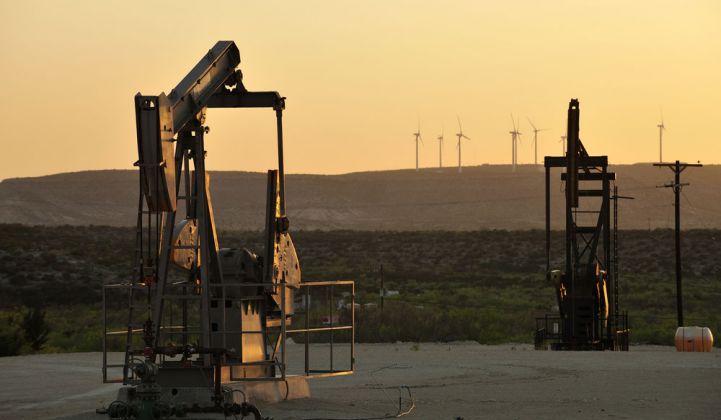The Texas grid has (mostly) kept the lights on despite having minimal reserve margins for years. But if ERCOT, which operates the state’s grid, implements the U.S. Environmental Protection Agency’s proposed Clean Power Plan to cut carbon dioxide emissions, it will reduce grid reliability in the state even further, according to a new analysis from the council.
“The timing and scale of the expected changes needed to reach the CO2 emission goals could have a harmful impact on reliability,” ERCOT wrote in its assessment. “It is unknown based on the information currently available whether compliance with the proposed rule can be achieved within applicable reliability criteria and with the current market design.”
The EPA has put Texas’s power-sector CO2 emissions at about 223 million metric tons, with an emission rate of 1,298 pounds per megawatt-hour. The EPA has proposed that Texas lower its emission rate to 791 lb./MWh by 2030.
The modeling examined various scenarios, two of which involved a price on CO2 emissions. A price of $20 per ton of CO2 did not allow ERCOT to meet either the interim or the final goal, but $25/ton would bring Texas below the interim goal and close to the final goal by 2030.
The EPA has assumed that Texas could reach a cumulative energy efficiency savings of nearly 10 percent by 2029 as part of meeting the goals, but ERCOT assumed a growth in energy efficiency of only 5 percent. “ERCOT did not elect to use the energy efficiency savings level estimated by EPA because this level of energy efficiency is not consistent with current trends in energy efficiency in Texas,” the report states.
ERCOT took a similar stance to the Midwest Independent System Operator (which also relies heavily on coal), of “moderate, more realistic” energy efficiency growth assumptions. But that doesn’t mean that more aggressive efficiency measures could not be implemented.
“ERCOT appears to have looked at growing existing energy efficiency programs, rather than the full-scale of what Texas could achieve under the CPP,” Jim Marston, director of the Environmental Defense Fund’s Texas office, wrote in a blog post. “Energy efficiency, one of the main building blocks in the CPP, is the best means to lower electricity prices for Texans.” Marston pointed to a Brattle Group evaluation that found for every $1 in energy efficiency investment, Texas could save $2 to $5.
Earlier this year, Texas launched its "PACE in a Box" program, which is designed to unlock efficiency measures across Texas -- particularly in heavy industry, which uses half of the energy consumed in the state. Also, ERCOT has already raised its market cap to $5,000 per megawatt-hour, and that will rise again to top out at $9,000 per megawatt-hour in 2015. The higher prices during peak times could incentivize more big energy users to participate in demand response or invest in efficiency upgrades.
But to really get anywhere near the EPA rules, Texas will have to retire coal, and lots of it. A total of 800 megawatts of coal is already slated to retire, but to meet the EPA regulations, the state will need to retire between 3,300 and 8,700 megawatts of coal. Models devised by both ERCOT and EPA showed that up to 9,000 megawatts of coal could be retired.
With gigawatts' worth of coal taken out of the picture, ERCOT found its reserve margins would be 2 percent to 3 percent lower than its baseline of nearly 14 percent. It also questioned where reliability services, including reactive power and voltage support, frequency response, and ramping capability, would come from.
But other resources could provide many of these services, and some could even be better at it than coal. Storage assets, such as grid batteries or even EV fleets, can provide frequency regulation. Ramping capability would need to be faster, especially to contend with solar and wind dying down in the evening hours, but that too could be provided by alternative resources. ERCOT is also changing its ancillary service market to better match the needs of increasingly distributed generation, which could mitigate the impact of retiring coal.
“The small relative size of the ERCOT market in relation to the Eastern and Western Interconnections has contributed to greater variability in frequency, creating a greater need for abundant operating reserves,” said Ben Kellison, director of grid research at GTM Research. “However, that need is increasingly being filled in other markets by distributed energy resources, most notably energy storage in the PJM market.”
Kellison added that the changes to the ERCOT ancillary services market “create some optimism around growing mid-term opportunities for distributed generation, storage and demand side management." ERCOT already has a pilot underway in which grid batteries and an electric vehicle fleet provide frequency regulation.
Grid balancing is just one issue of reliability, however. ERCOT also anticipates that its Competitive Renewable Energy Zones transmission project, which was recently completed, will not provide enough transmission capacity for new renewable generation -- most of which will likely be solar -- even though CREZ currently has extra capacity.
Even without the cost of new transmission, some of which is already planned, bills could increase by up to 20 percent for customers in the short term, though that level is likely to fall to only 5 percent to 7 percent by 2029, according to ERCOT. But a recent Natural Resources Defense Council analysis found that the EPA's assumptions about the costs of renewables and efficiency are too conservative and not in line with current costs. As such, the cost to implement the Clean Power Plan is actually lower than the EPA and many states are estimating.
ERCOT is asking the EPA to take grid reliability issues into account for its planning to meet Clean Power Plan goals, particularly in the short term. A full report on the regulatory impact of the EPA rules in Texas is expected before the end of the year.



